CRS Scientist Spotlight on Juhi Narula
Being curious is what drives research, so even if you think a question might have a simple answer, don’t be afraid to ask.
Juhi Narula
Juhi Narula is a 3rd year IBiS graduate student in Dr. Sadie Wignall's lab. She is also a second year participant in the CRS Predoctoral Training Program in Reproductive Science, Medicine and Technology. Her research focuses the role of a conserved kinase in oocyte meiosis, utilizing the nematode Caenorhabditis elegans as a model system

Thesis mentor: Sadie Wignall, PhD
Thesis title: Investigating the role of a conserved kinase in acentrosomal spindle organization using C. elegans oocytes
What brought you to join the CRS community and what is your current position?
I am currently a third year PhD candidate in the lab of Sadie Wignall, and in my second year of the CRS Predoctoral Training Program in Reproductive Science, Medicine, and Technology.
Could you describe your research?
I am investigating the role of a conserved kinase in oocyte meiosis, utilizing the nematode Caenorhabditis elegans as a model system. Meiotic chromosome segregation in female oocytes is highly error-prone. It is estimated that 10–30% of fertilized human eggs are aneuploid, resulting in a high incidence of miscarriages and birth defects, and most of these abnormalities are the result of chromosome segregation defects in the oocytes. A distinctive feature of oocytes in various organisms including humans and C. elegans is that they lack centrosomes. Despite this being a common feature in oocytes, how acentrosomal spindles are formed and stabilized remains poorly understood.
The goal of my proposed research is to understand the role of a conserved kinase in meiosis, fitting this protein into a larger model for acentrosomal spindle assembly. These findings will inform our understanding of how the meiotic spindle organizes in the absence of centrosomes and how the female oocyte is able to properly segregate chromosomes.
What aspect(s) of CRS do you find most valuable?
I feel very fortunate to have been able to present my work at various CRS meetings, including the Reproductive Science and Medicine Summit and the Reproductive Research Updates. These opportunities have allowed me to improve my presentation skills as well as get feedback from experts in the reproductive science field.
What has been the most valuable aspect to your training as a reproductive scientist?
The CRS training grant has given me many opportunities, including journal clubs and various technology primers, to improve my scientific communication abilities and enhance my reproductive science knowledge. As a result of these resources, I have grown to understand and appreciate a broader range of reproductive biology topics than my bench training alone would have exposed me to. It has also helped me connect with other scientists in this community and learn from their expertise.
What is one piece of advice you would give to young scientists starting in their journey in science?
I would advise young scientists to not be afraid of asking seemingly silly questions. Being curious is what drives research, so even if you think a question might have a simple answer, don’t be afraid to ask. The answer might even give your research a new direction!
What do you think will be the next big contribution in the reproductive biology field?
There have been many advancements in science related to CRISPR genome editing, iPSCs/ in vitro modeling, and meiosis. I am curious and excited to see how progress in these areas will be used to resolve reproductive issues such as infertility.
What hobbies do you have outside of the lab?
I enjoy exploring bakeries in Chicago and Evanston, dancing, and hiking.